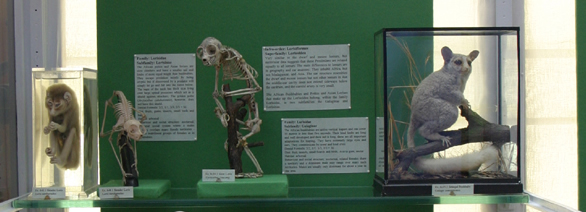
ORDER PRIMATES
SUBORDER STREPSIRHINI
LEMURS, AYE AYE, BUSH BABIES OR GALAGOS, LORISES
Strepsirhines are a diverse group of small animals adapted to specialised ecological niches in Africa, Madagscar and Asia. Their name means twist-nose. These woolly coated mammals have pointed snouts with moist noses, prominent whiskers and a divided upper lip tied to the gums by a membrane. The naked moist area of skin on the snout (the rhinarium) is linked to their sense of smell. They have monkey-like hands. The woolly fur acts as insulation and serves to dispense the scent which plays an important role in the social and territorial behaviour of these mammals. Strepsirhines have special grooming tools to keep their woolly coats in good condition: a spatulate fur-grooming claw on the second digit of the foot and projecting tooth combs. Mainly nocturnal creatures, strepsirhines possess a light reflecting disc in the eye – the tapetum lucidum - to aid night vision. Strepsirhines are distinguished from haplorhines by a number of physiological and morphological features of the inner ear, blood circulation and digestion. Strepsirhines have a simple placenta and the embryos have many membranes between them and their mother’s blood.
 |
|||
 |
|||
SKULLS AND DENTITIONStrepsirhine skulls have:
Strepsirhine jaws and teeth are simple compared to many mammals. The two halves of the lower jaw are separate. The usual tooth formula is I2/2; C1/1; P 3/3; M3/3 = 36. The four lower incisors and two canines project forward to form a toothcomb. The upper and lower molars are squared off typically with four cusps. The molar cusps are usually low but are sharper and higher in insect or leaf eating species. The aye aye is an exception: it has only a set of small cheek teeth and powerful continuously growing incisors. |  |
GEOGRAPHICAL LINEAGES OF STREPSIRHINES
Geographical isolation led to the evolution of two distinct groups of strepsirhines. Lemurs and the aye aye (infraorder Lemuriformes) live exclusively on Madagascar, an Island off the East Coast of Africa. Galagos and lorises (infraorder Lorisiformes) are more widespread being found on mainland Africa and Asia. Our specimens illustrate some of the more specialised morphological and behavioural features which enabled lemurs, bush babies, lorises and the aye aye to exploit a variety of ecological niches.
| INFRAORDER LEMURIFORMES | INFRAORDER LORISIFORMES |






